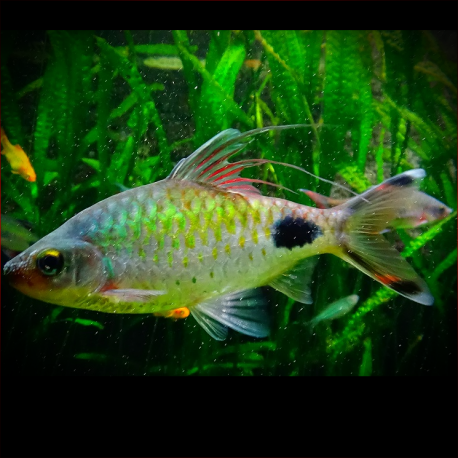More info
Datasheet
| Minimum Tank Size | 240 litres / 63.40 US gallons |
| Maximum Size | 12.0cm / 4.72inches |
| Temperature | 20°C / 68.00°F - 25°C / 77.00°F |
| Hardness | 2.02dgH / 36ppm - 15.02dgH / 268ppm |
| pH | 6.0-7.0 |
Behaviour
An ideal addition to a peaceful community of riverine species alongside other schooling or shoaling cyprinids plus botiid, cobitid, nemacheilid, and balitorid loaches. If geography isn’t an issue, it can be combined with most peaceful fish of a size too large to be considered food, having a bold enough disposition to not be intimidated by its size and active nature. Thorough research is crucial when selecting a compatible fish community. A schooling species by nature, ideally 8-10 specimens should be purchased for a more effective, natural-looking display. Any aggressive behavior is usually contained as males focus on maintaining their hierarchical position within the group.
Feeding and Diet
The Filament Barb is likely a foraging omnivore, feeding on worms, insects, crustaceans, plant material, and other organic debris in nature. In the aquarium, offering a balanced diet including small live and frozen foods such as bloodworms, Daphnia, and Artemia, alongside high-quality dried flakes and granules, will ensure optimal condition and vibrant colors.
Reproduction & Dimorphism
This egg-scattering free spawner exhibits no parental care, spawning often when in good condition. In a mature aquarium, fry may appear without intervention, but controlled conditions can maximize yield. Adult males display a more intense color pattern and tubercules on the head when in spawning condition. Females grow slightly larger, are heavier-bodied, and less colorful. Both sexes may develop filamentous dorsal fin rays, depending on the population.
Habitat and Distribution
Endemic to the Western Ghats mountains region of southern India, the Filament Barb is widespread in Kerala, Tamil Nadu, and possibly limited to the south of Karnataka. Commonly found in lowland coastal floodplains, it inhabits fresh and brackish waters of rivers, estuaries, coastal marshes, and reservoirs.
Aquarium Setup
The tank should resemble a flowing stream or river with a substrate of rocks, sand, fine gravel, and driftwood. Hardy aquatic plants like Microsorum, Bolbitis, or Anubias spp. can be grown attached to the décor. Regular water changes of 30-50% tank volume are recommended, with water conditions maintained at a pH of 6.0-7.0, hardness of 36-268ppm, and a temperature of 20-25°C.
(Note: Do not rewrite the table, refer to it by stating "see table". All content is based on the provided information.)

